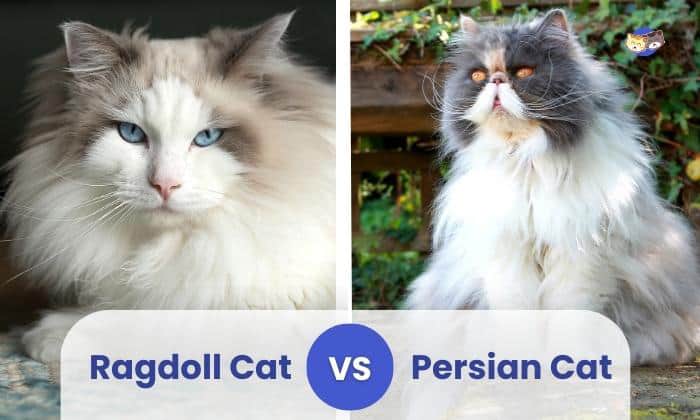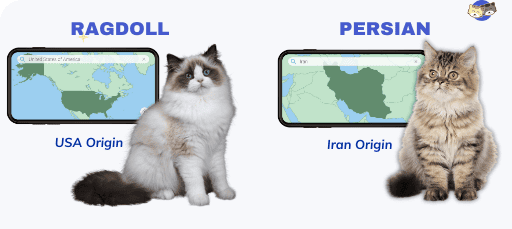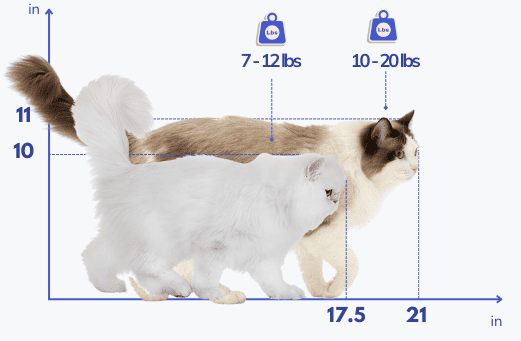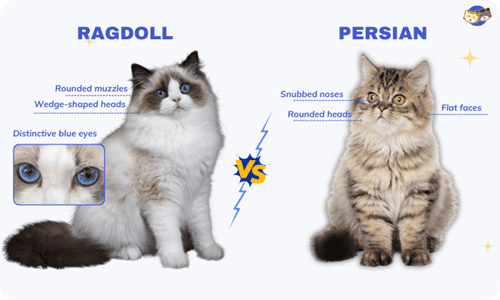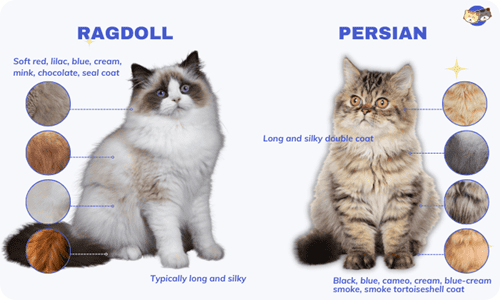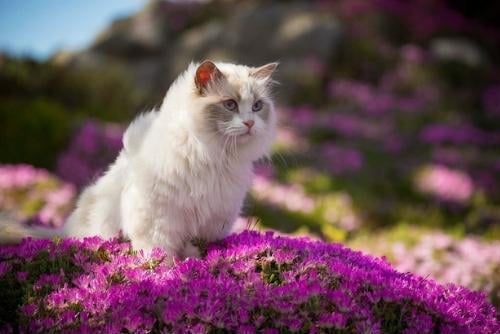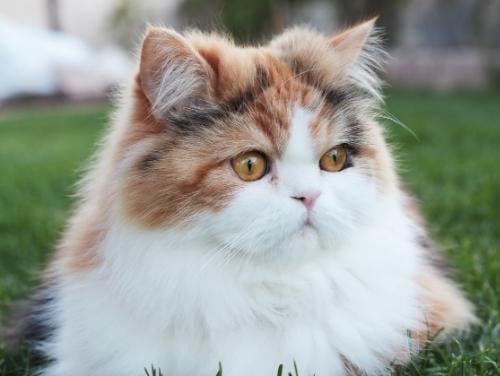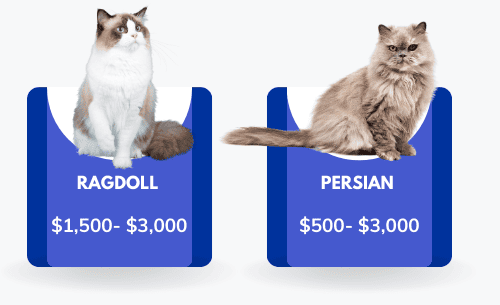If you’re a cat lover, you are likely familiar with most breeds and can distinguish one from another based on appearances. However, physical characteristics or cat price should not be the only thing to consider when you’re thinking about adopting a pet. Each breed has its own set of requirements in terms of grooming, training, and so much more.
In this article, we will help you choose between two adorable and family-friendly breeds: Ragdoll vs Persian cat.
| Ragdoll | Persian Cat | |
| Origin | USA | Iran |
| Lifespan | 13 to 18 year | 10 to 15 years |
| Height (Adults) | 9 to 11 inches | 8 to 10 inches |
| Length (Adults) | 17 to 21 inches | 14.5 to 17.5 inches |
| Weight (Adults) | 10 to 20 lbs | 7 to 12 lbs |
| Grooming needs | Once or twice a week | Once or twice a day |
| Temperament | Playful | Submissive |
Table of Contents
Difference Between Persian and Ragdoll Cats
1. History
- Persian
No one knows when Persian cats came into existence. However, records suggest there were similar-looking felines in Italy sometime in the 1500s, later bred with a cat from Persia.
Other sources say these cats originated from Mesopotamia (or now, modern-day Iran) and were brought to Europe in the 17th century. However, the breed’s origin can be traced all the way back to 1684 BC.
- Ragdoll
The origins of the ragdoll cats are well-documented since they were bred from Birman and Persian cats by Ann Baker back in the ‘60s in California. Fun fact: The feline breed got its name when it slumped on the owner’s arms like a ragdoll.
2. Body size
As shown in the Persian vs ragdoll cat comparison table, the latter is longer and taller than the average Persian cat size.
- Ragdoll cats can grow as tall as 11 inches and as long as 21 inches. Moreover, they also have short yet thick necklaces and bushy tails. Given the ragdoll’s muscular build, they often weigh between 10 and 20 pounds.
- On the other hand, the tallest Persians are roughly 10 inches, and their length can span up to 17.5 inches, weighing about 7 to 12 pounds.
Unlike Manx, Siamese, and other cat breeds with good jumping abilities, Persians like to stay on the ground, which is why their bodies and legs are stout.
3. Facial features
Besides the height and length, the cat’s facial features can provide clues about its breed.
- Ragdolls are characterized by their distinctive blue eyes, rounded muzzles, and wedge-shaped heads. Unlike Persian felines, Ragdolls don’t have flat
- By contrast, modern-day Persians have rounded heads, snubbed noses, and flat faces. However, note that the doll-face variety has regular noses.
4. Coat
- Shedding level and grooming needs
A ragdoll’s coat is typically long and silky. Thankfully, they are low-shedding, but it’s worth noting that it is not a hypoallergenic breed. Needless to say, you should brush its coat to avoid matting.
Due to their long and silky double coat, a Persian cat must be brushed daily with a wide-tooth comb. And since it isn’t hypoallergenic, it can easily trigger allergic reactions.
- Color
Available in gorgeous colorpoint, mitted, or bicolor patterns, a ragdoll’s coat features soft red, lilac, blue, cream, mink, chocolate, and seal.
By contrast, a Persian cat boasts a double coat in black, blue, cameo, cream, blue-cream smoke, or smoke tortoiseshell with classic, patched tabby and mackerel patterns.
5. Temperament
Although Persian and ragdoll are different physically, they are similar in temperament.
For starters, they are both awesome companions due to their affectionate nature. Moreover, they prefer to stay on the floor rather than jump all over the house. These breeds are known for their quiet demeanor, making them perfect for apartment dwellers.
6. Health
Considering that ragdolls were bred with Persian cats and other breeds, the former inherited some of their parents’ genes.
But while both breeds are prone to contracting certain diseases, ragdolls are likelier to get sick more often. They are prone to problems such as:
- Hypertrophic cardiomyopathy (HCM) — a result of the thickening of heart muscles.
- Urinary tract infections
- Hairballs
- Obesity
- Gastrointestinal issues.
That said, just because Persian cats are less likely to contract HCM does not mean that they do not require regular examination. Their breed can contract bladder stones, cystitis, polycystic kidney disease, and liver shunts.
7. Cost
The cost of cat breeds varies depending on the breeder, show record, and whether you’re choosing between pedigree and non-pedigree. For ragdolls, expect to pay $1,500 to $3,000.
If you don’t want to spend thousands of dollars, you’d be happy to know that Persian cats are available for as low as $500. However, show cats, white-coated Persians, as well as purebred ones, can have a price tag of a whopping $3,000.
Which Breed is Right for You?
Generally speaking, Persian and ragdoll breeds are suitable for families of any size, provided no one is allergic to cats.
However, it is worth noting that Persian cats prefer gentle affection over rowdy children or dogs, which is why they are recommended for older children and the elderly. Aside from that, they like to interact with their human companions and require regular grooming and bathing. To maintain a healthy-looking coat, they must be brushed twice daily.
If your lifestyle does not enable you to meet those demands, you will enjoy caring for ragdoll cats. They are low-maintenance since they only need brushing once or twice a week.
Conclusion
Understanding the key differences between a ragdoll vs Persian cat is crucial in determining the right breed for you and your family.
If you have to go to your office for long periods, you might find it extra-challenging to care for a high-maintenance cat like Persians. In this case, ragdolls would be perfect for you, since they do not require daily brushing.
However, this breed will cost you an arm and a leg. If you want something more budget-friendly and can commit to brushing your cat’s fur daily, then your Persians are your best bet!

I pursued veterinary studies at the University of Kansas. After several years of practice, I established a veterinary clinic in Kansas. When Michael extended an invitation with a vision that went beyond emergency support – sharing of caregiving information for guardians to create the best living environment for cats, I didn’t hesitate to join the organization.
My role here involves verifying the information presented on the official website. With my experience, I believe the information provided is entirely accurate. If you have any concerns, please feel free to reach out to me


